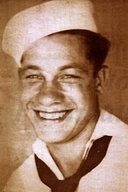
|

|
|
|
|
He was born in Kansas City, Kansas as one of four children of Elmer Burton Barns and Rosetta Marie Slyter Barns. His father was a railroad worker, farmer, and mechanic. Kenneth grew up near Havana, Kansas, on a farm where the family raised wheat and corn. "Real hard," he calls his childhood during the Depression. "You went to the grocery store and the only thing you bought was coffee and staples," he says. The family ground their own wheat and cornmeal, and raised vegetables, cattle, and hogs. His mother canned, cooked on a wood stove, and washed clothes outside in a black pot. For entertainment the family listened to the radio and watched silent movies projected onto a sheet on the side of a downtown building. On Sundays they attended a Methodist church. Kenneth enjoyed fishing and hunting for squirrels and rabbits, and earned income as a paperboy for The Wichita Eagle Eye. After graduating from Havana High School in 1938, he worked for a soft ice cream plant in Kansas City. Entering the U.S. Navy on September 10, 1940 he finished boot camp at Great Lakes Naval Training Center in North Chicago. He was sent to Bremerton, Washington, where he was assigned to the USS West Virginia (BB-48) as a fireman firing and repairing boilers. His combat station was the blower room where blowers regulated the temperature in the firebox that heated water for steam to run the turbines. The ship soon sailed to Pearl Harbor as part of 7th Fleet, and participated in maneuvers, including target practice. In 1941 he was on the ship's quarterdeck and preparing to go ashore on liberty call when the Japanese attacked on December 7th . "We took three torpedoes. Bang! Bang! Bang!" he recalls. He sprinted towards his duty station below deck when "general quarters" was sounded, but all watertight hatches were closed and sealed. Instead, he boarded a motor launch and helped pick up "one hundred or one hundred and fifty survivors" from the water. "I didn't know what to think," he recalls of the attack, which, he says, "was all over in thirty minutes." Later that day, personnel were taken to a tent where they were fed, then given weapons and ordered aboard a flatbed truck. For the rest of the day and night, he says, "we patrolled up and down Pearl Harbor." Kenneth served briefly aboard the USS Salt Lake City (CA-25), then the USS Sumner (AGS-5), a survey ship. From the latter vessel, smaller craft called sound boats entered shallow harbors and mark with buoys mooring spots for large, deep-draft ships. Kenneth was trained also as a diver and rigged dynamite to blast out coral in shallow harbor. He used diving suits occasionally. "We had on lead belts and lead shoes, but you could walk on the bottom. It was beautiful. I enjoyed that," he says of diving duties around places like New Guinea and the Solomon Islands. Kenneth "island-hopped" to Japan, where he was working as a diesel mechanic an LST when that nation surrendered. He was discharged in San Pedro, California, in September of 1946, although his official discharge date was November 24, 1946. He came to Shreveport, where his parents had moved in 1941 so his father could work in an ammunition plant in Minden. On December 10, 1946 he married Elaine Larance, who passed away on September 26, 1986. Kenneth worked as a mechanic for heavy-duty construction equipment in Shreveport and California. After earning a degree in business from Louisiana Tech in 1953, he worked as an accountant for City Service Oil Company, then as an investigator for the State of Louisiana, retiring in 1982. Kenneth belongs to the Pearl Harbor Survivors Association. |


